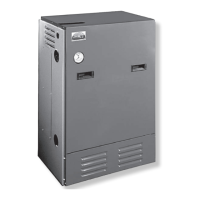25
Consideration for the following should be used when
6.
determining an appropriate location for termination of
combustion air and vent piping.
Comply with all clearances required as stated in paragraph •
7.
Termination should be positioned where vent vapors will •
not damage plants/shrubs or air conditioning equipment.
Termination should be positioned so that it will not be ef-•
fected by wind eddy, air born leaves, snow, or recirculated
ue gases.
Termination should be positioned where it will not be •
subjected to potential damage by foreign objects, such as
stones, balls, etc..
Termination should be positioned where vent vapors are •
not objectionable.
Put vent on a wall away from the prevailing winter wind. •
Locate or guard the vent to prevent accidental contact
with people or pets.
Terminate the vent above normal snowline. Avoid loca-•
tions where snow may dri and block the vent. Ice or
snow may cause the boiler to shut down if the vent be-
comes obstructed.
Under certain conditions, ue gas will condense, form-•
ing moisture, and may be corrosive. In such cases, steps
should be taken to prevent building materials at the vent
from being damaged by exhaust of ue gas.
e venting system shall terminate at least 3 feet above any
7.
forced air inlet (except the boiler’s combustion air inlet)
within 10 feet. e venting system shall terminate at least
12 inches from any air opening into any building. e
bottom of the vent shall be located at least 12 inches above
grade. Termination of the vent shall be not less than 7 feet
above an adjacent public walkway. e vent terminal shall
not be installed closer than 3 feet from the inside corner of
an L shaped structure. Termination of the vent should be
kept at least 3 feet away from vegetation. e venting sys-
tem shall terminate at least 4 feet horizontally from, and in
no case above or below, unless a 4 foot horizontal distance
is maintained, from electric meters, gas meters, regulators,
and relief equipment.

